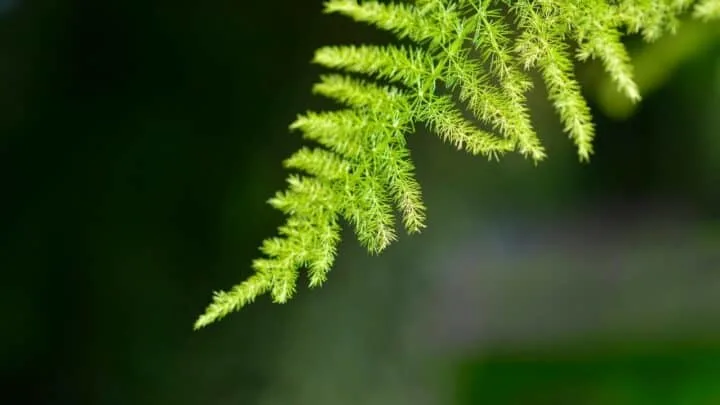You are reading this article to learn more about Plumosa fern and its care.
Plumosa fern

The Plumosa fern, or Asparagus fern, is one of the easiest houseplants to grow for beginners.
The scientific name for Plumosa fern is Asparagus plumosus.
The gorgeous rich green and feathery foliage gives it a distinctive airy look.
Although the Plumosa fern looks much like a fern, it belongs to the Asparagaceae family and is not classified as true.
The plant is scientifically known as Asparagus setaceus or Asparagus plumosus, according to NC State University.
Takeaways
| Species | Asparagus plumosus |
| Synonyms | Lace Fern, Asparagus Fern, Plumosa Fern |
| Family | Asparagaceae |
| Genus | Asparagus |
| Growth | Climbing, Cascading |
| Height | 2.0 ft (0.61 m) / 24.0 in (61.0 cm) |
| Width | 4.0 ft (1.22 m) / 48.0 in (121.9 cm) |
| Soil | Well-draining soil mix |
| Watering | Every 7-10 days |
| Light | Bright indirect |
| Temperature | 15.6 - 23.9 °C / 60.1 - 75.0 °F |
| Humidity | 40.0% - 60.0% |
| Fertilizer | Once a month in spring and summer |
| Propagation | Division or stem cuttings |
| Toxicity | Toxic to humans, cats and dogs |
Plumosa Fern Care
The Plumosa fern can tolerate various soil types but prefers loose, well-aerated, and consistently moist soil. 4-6 hours of bright indirect light are all it needs. Water frequently every time the top 2 inches (5cm) of soil dry out. Optimum growing temperatures are 65-80°F (18-26°C) and humidity above 70%. Fertilize every four weeks in spring and summer with a liquid fertilizer diluted to 1/4 of its strength.
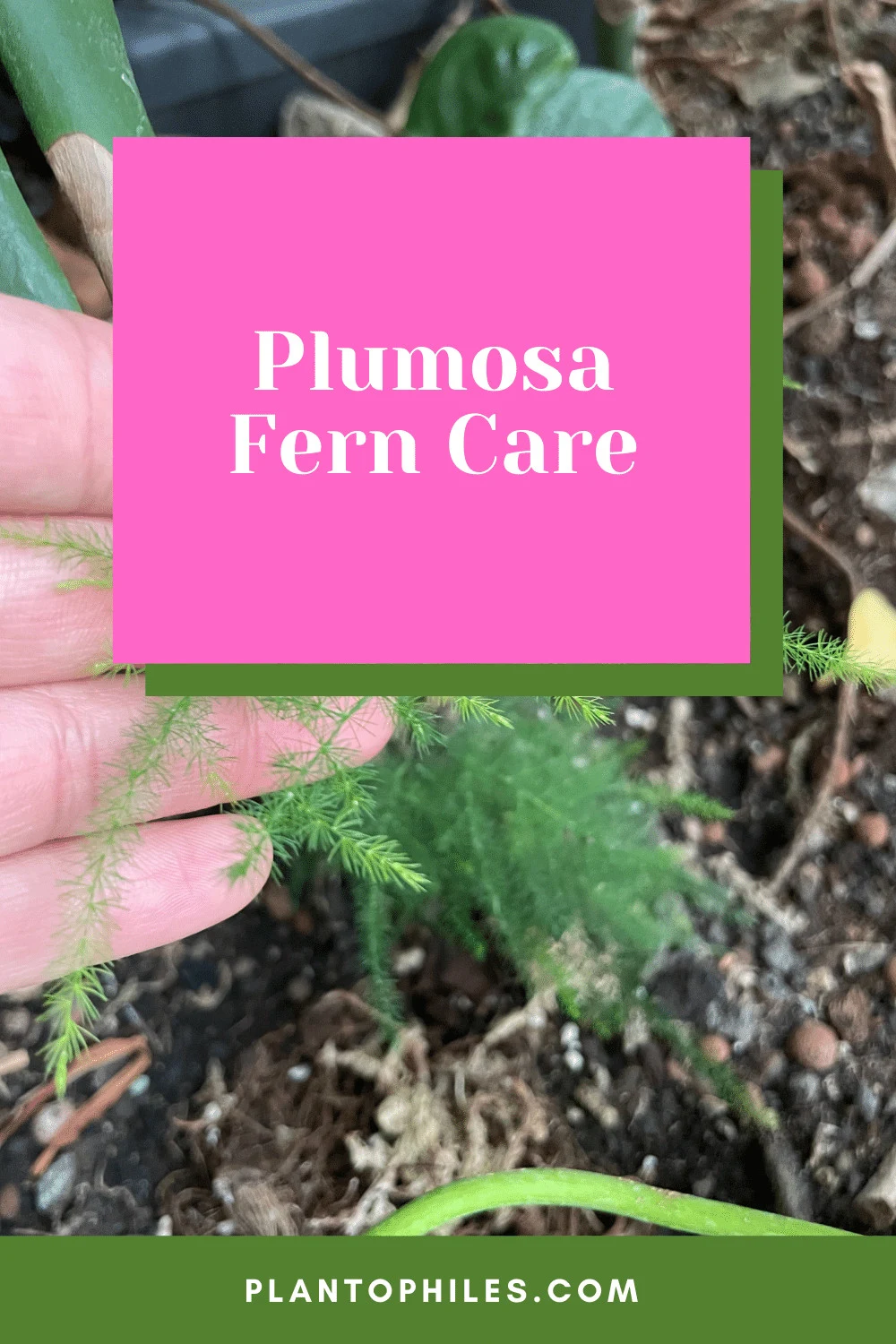
Table of Contents
Plumosa Fern Care Guide
Soil
The Plumosa fern will thrive in loose, well-aerated, and consistently moist soil. It prefers acidic soil types. It can tolerate varying soil types, but aeration and drainage cannot be compromised. Regular houseplant potting soil with significant portions of organic matter and perlite is perfect.
Good drainage, soil aeration, looseness, and consistent moisture seem tough to achieve.
But with just a few additional soil ingredients, you can make the soil perfect for growing an Asparagus fern.
Ferns thrive in fertile soil that is rich in organic matter. High organic content in the soil acts as a long-lasting, slow-releasing supply of nutrients for the plant.
Although your Plumosa fern will do well in a regular houseplant potting mix, you can add perlite and organic compost to increase the soil water retention, enhance drainage and aeration and make the soil loose.
Loose soil means that the soil particles do not stick together and get compacted.
Roots can grow freely in loose soil without making much of a drilling effort.
Using various materials to make your potting mix ensures that the soil comprises differently-sized particles.
This prevents soil compaction and also increases aeration and drainage ability.
Perlite and organic material are porous and can absorb excess water and store it inside.
The thousands of tiny perlite and compost units act as water absorbers and hold a lot of extra moisture inside.
When the soil around them gets dry, these units release the water slowly to supply the roots with moisture.
This ensures consistent moisture and reduces the risks of underwatering and overwatering.
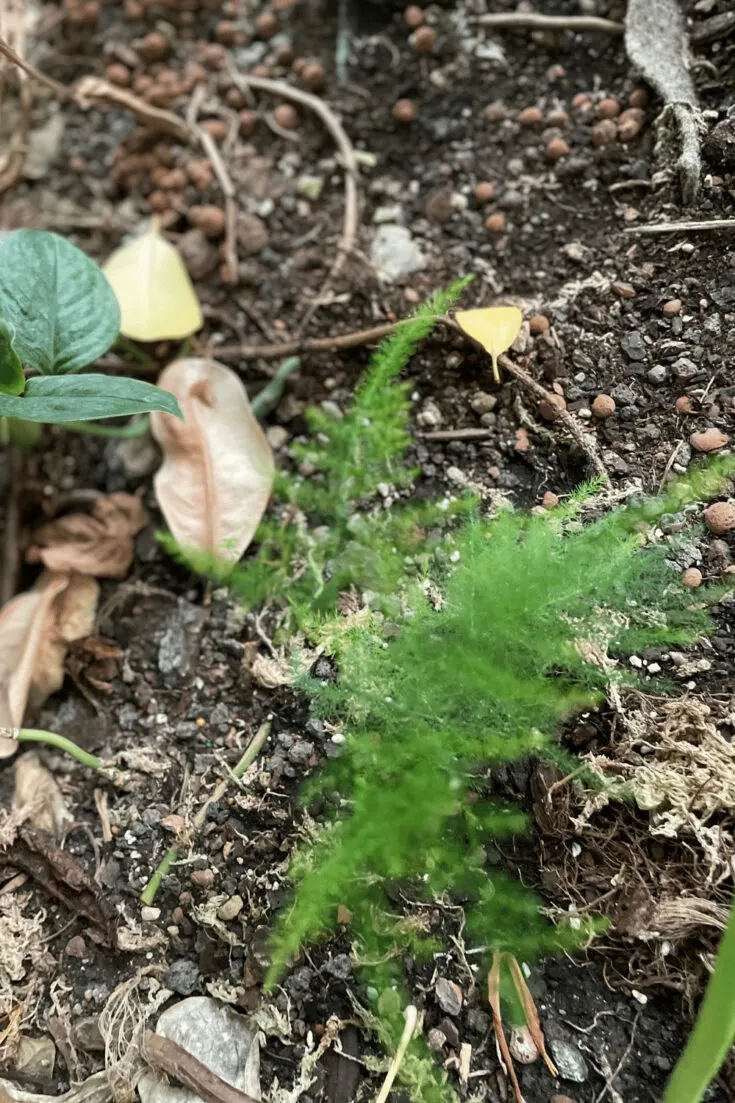
Light
Plumosa fern does not require a lot of sunlight and will thrive in bright indirect light. 4-6 hours of bright indirect light are more than enough. It can also survive in relatively low light conditions. Protect it from direct sunlight, as the foliage can turn yellow and burn in intense sunlight.
The Plumosa fern naturally grows on the forest floor, beside tree trunks, large rocks, and under the dappled shade of the forest canopy.
These plants can tolerate heavy to light shade but will not like harsh sunlight for extended periods.
To encourage optimum growth, try to mimic the natural growing conditions for your Plumosa fern.
These are perfect plants to grow beside tree trunks and in baskets hanging under a tree’s shade.
You can also grow this plant next to a shaded wall, on your patio, and indoors.
The fronds can start turning yellow if the plant is receiving excessive light.
If you spot this symptom, move the plant away from the light source and see if the yellowing stops.
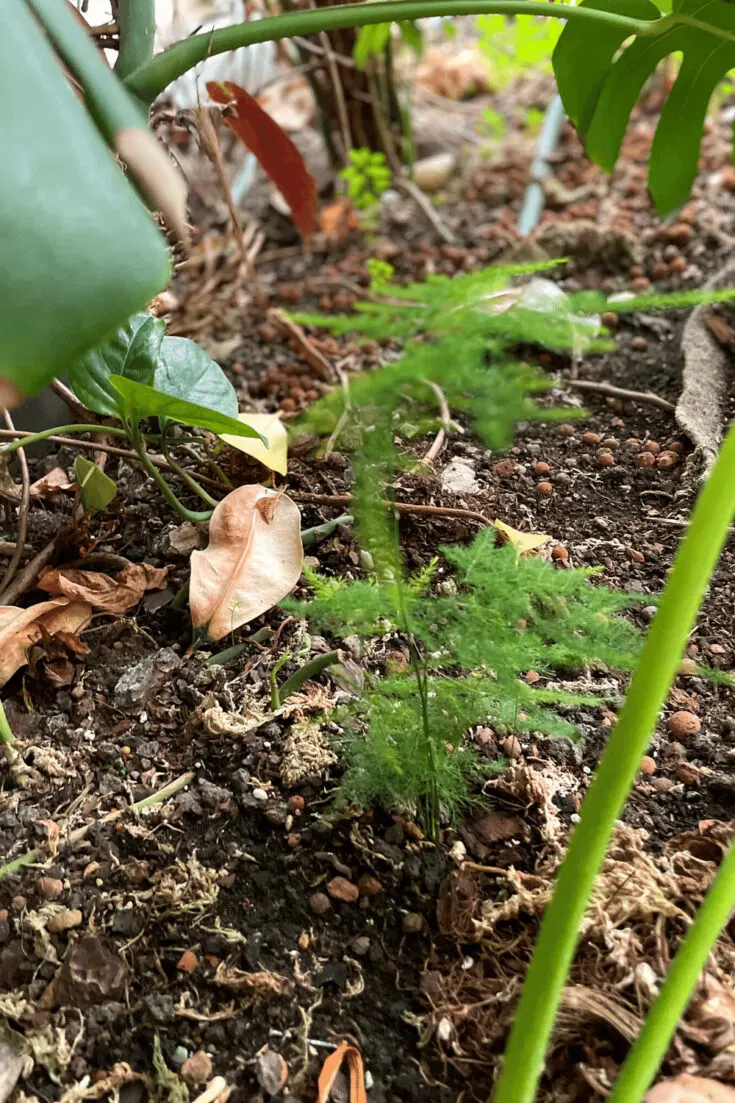
Watering
The Plumosa fern is considered a heavy water drinker. You will have to water it more often than you water other plants. It needs consistent soil moisture, so you must water it frequently. Water this plant moderately every time the top few inches of soil dry out.
Asparagus fern needs a lot of water due to the high rate of water transpiration through its foliage.
The foliage of this plant is feathery in texture, which means a significantly larger surface area for transpiration.
This fern needs ample soil moisture because a lot of water is lost to the atmosphere through transpiration.
You cannot leave this plant without water for a long time as it can quickly shed most of its foliage. In the same way, overwatering can lead to worse symptoms.
Feel the top layer of soil with your finger to check for moisture and whether it is the right time to water your Asparagus fern. If the top two inches feel bone dry, it needs water.
If a Plumosa fern is neglected for a long time and is thirsty, it will lose its foliage and its stems will turn brown. Although it can look dead on the surface, this plant can be pretty much alive.
You may find lush green growth bouncing back once you rehabilitate the plant by providing it with adequate water again.

Temperature
The Plumosa fern can easily be grown indoors as regular indoor temperatures are the same as the optimum growing temperatures for this plant, 65-80°F (18-26°C). It prefers a protected environment where temperatures do not fluctuate drastically. It can be grown all year outdoors in USDA zones 9-11.
This plant naturally grows in warm and humid environments where the temperature rarely dips below freezing.
However, this plant is relatively cold-hardy and can tolerate temperatures as low as 20-30°F (-1 to -7°C).
Plumosa fern plants can tolerate temperatures as high as 95°F (35°C) on the hotter side. The growth slows down if temperatures cross this upper limit.
If you live in a climate cooler than USDA Zone 9, bring your Plumosa fern indoors or to a protected greenhouse to help it survive the winter.
The delicate feathery foliage stays green all year but will die if it comes into contact with frost.
Protect the plant from direct sunlight through a glass window if growing indoors. Sunlight passing through glass gets intensified and tends to burn the foliage.
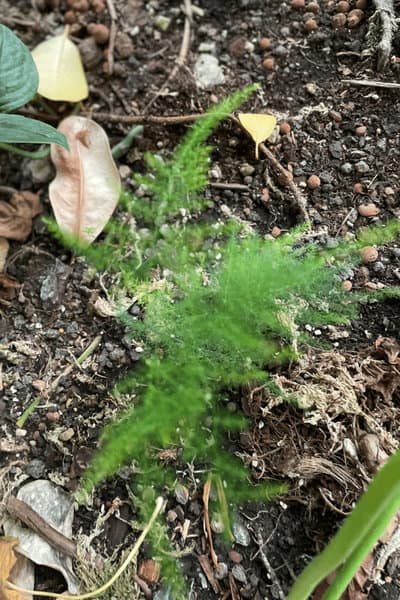
Humidity
Asparagus ferns grow rampantly in high humidity. They will love humidity levels above 70%. Regular indoor humidity levels are inadequate for this plant, and you must make up for using artificial humidity sources. The foliage may get brown at the edges due to a lack of humidity.
Maintaining the required humidity levels is one of the most essential parts of Asparagus fern care.
Even if you get everything else right, the plant will still not grow well if the proper atmospheric humidity is missing.
If you have to overwinter the plant, placing it in a warm and humid greenhouse is the best thing you can do to help it spend the winter.
Inside the home, typical indoor humidity levels are too low for an Asparagus fern to thrive. Using a humidifier or pebble tray then becomes a must.
If your bathroom temperatures are regulated, and there is adequate light in there, there is a better place to grow a fern in your home.
A bathroom’s naturally high humidity levels are perfect for many plants and are just what your Plumosa fern needs to thrive.
Fertilizer
The Asparagus fern is not a heavy feeder, so fertilizing it is unnecessary. You can feed the plant with fertilizer every 3-4 weeks to encourage fast growth and rich foliage in spring and summer using 1/4 of the recommended strength.
Overfertilization can easily lead to plant burning, so always dilute it before feeding your plant.
Fertilizing a Plumosa fern needs special care. Not because it is an essential factor in this plant’s care but because it will easily do more harm than good if done carelessly.
Overfertilization can make a majority of the foliage turn brown and die. So always apply mild doses and dilute the fertilizer to half strength before feeding.
I was watering the plant once before fertilizing reduces the risk of root tip burn, which occurs when excess fertilizer is added to the soil and sucks away moisture from the roots.
Growth
The Plumosa fern is usually grown as a perennial or a ground cover. Clumps can grow up to 2 feet in height and 5 feet laterally. The leaves are long and feathery. The cascade down from the clump of stems forms an umbrella-like canopy. Because they are not true ferns, they flower and produce seeds.
Asparagus fern grows in clumps. The frilly feather-like gives a soft and fuzzy look, but upon a closer look, you will find they have sharp spurs.
Because this plant is not a true fern, it also produces white flowers and seeds. It will only blossom during the growing season and produce green-black berries.
The plant enters winter dormancy and may shed its foliage right before spring.
Potting
Asparagus ferns will need a small-medium-sized pot to grow and do not need a large pot, unlike other ferns. They are ornamental plants that look good in glazed or hanging pots. However, terra cotta pots are recommended over other materials for their benefits.
The Plumosa fern will thrive if put in a small pot that is slightly root-bound. Hanging pots are a good choice for their aesthetic.
Adding a layer of pebbles or rocks to line the bottom layer of the pot is excellent for maintaining good drainage and preventing the drainage hole from getting clogged.
Pruning
The Plumosa fern can easily grow out of its space and must be pruned back to maintain its shape and size. You must remove dead foliage and other damaged parts of the plant. Annual pruning also stimulates healthy foliage growth.
As it grows big, it can tangle with other plants and create a mess. Annual pruning is hence needed.
When growing outdoors in the ground, the Asparagus fern also has an invasive tendency and may start occupying other plants’ space. It can also develop as an epiphyte.
When pruning this plant, wear gloves to protect your hand from the thorny spurs on the foliage.
Plumosa Fern Propagation
Plumosa ferns can be propagated through seed and plant division. You can sow ripe berries directly into starting mix for them to germinate. You can easily separate new clumps from the root ball for plant division and carefully transplant them to a new pot.
Plumosa fern can only be propagated through seeds if you get your hands on its seeds.
And that will only happen if it blooms and fruits at your home, which is a rare occasion when this plant is grown as a houseplant.
You can plant the seeds in the germinating mix, keep them moist, and plants are expected to germinate within two weeks.
Plant division is the vegetative way to propagate Asparagus fern. You can separate plants by identifying separate clusters of tubers.
Pot the separated clusters in a similar potting mix. Dab the soil on all sides to eliminate air pockets and water well.
Cover the plant with a plastic bag for a week or two to speed up the propagation process.
Common Problems with Plumosa Fern
The Plumosa fern is not particularly susceptible to many pests or diseases.
The foliage is not very fleshy or juicy to invite parasitic pests.
Neither is the plant susceptible to many fungus-related problems.
The only problems you will have to worry about are the common root rot or the plant’s toxicity to animals.
Conclusion About Plumosa Fern Care
Plumosa fern is one of the most beautiful and least demanding houseplants you can grow.
The grace of the cascading foliage gives the plant a look of a miniature forest.
Whether growing on your patio, in your living room, or in the bathroom, this plant will surely add an airy, classy look wherever it’s planted.
FAQ
Do Plumosa ferns have bulbs?
Plumosa ferns do have underground bulb roots, also called tubers. These thick roots work to retain moisture and keep the plant alive even when it seems dead. They can be used to separate clumps.
Is Plumosa fern edible?
Although dubbed the Asparagus fern, these plants are not edible. Moreover, this plant is poisonous to dogs and cats.
I hope this Plumosa fern care was helpful!

Daniel has been a plant enthusiast for over 20 years. He owns hundreds of houseplants and prepares for the chili growing seasons yearly with great anticipation. His favorite plants are plant species in the Araceae family, such as Monstera, Philodendron, and Anthurium. He also loves gardening and is growing hot peppers, tomatoes, and many more vegetables.

